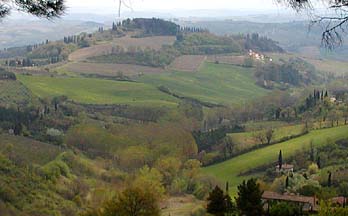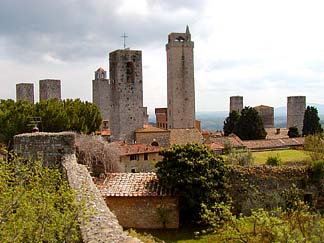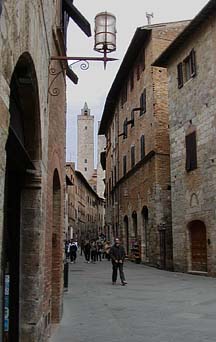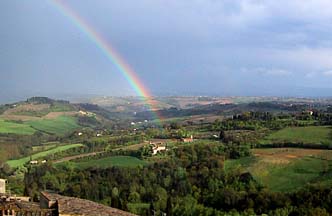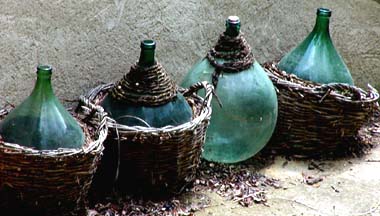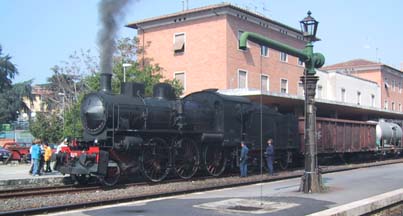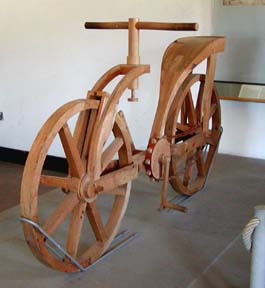|
We arrived in San Gimignano in April of 2002 and enjoyed 4 days in this lovely hill town. Most of the town was built in the 13th century and its trademarks are the numerous towers (14 of the original 72 are still standing). By the early 1300s the town was known for its cloth merchants and was quite prosperous. Then a plague hit in 1348 decimating the population and allowing Florence to eclipse San Gimignano in political and economic importance. There were two further serious plagues in 1464 and the great bubonic plague in 1631 sealed the fate of San Gimignano to be “frozen” in time as little development progressed during and after these times. However, this is to the benefit of all those who visit today as the town is pretty much preserved as it was in 1300. There appear to be 2 suppositions regarding the numerous towers. One is that each family was trying to show its wealth and power by building the tallest tower. The other is that they provided the much needed space to dry the dyed cloth, as San Gimignano’s main industry was cloth-making.
We took a walk around the outside of the walls which took a couple of hours, but provided wonderful views of the surrounding areas (above, left).
|
It is quite a tourist trap, but a beautiful and interesting one at that. Vehicle traffic other than the local residents is prohibited within the walled city and even then is limited to a few main access streets. The city retains most of the outer walls (originally built in 1236) with its 6 gates. At right is a view of the Via San Giovanni, just inside the gate. This is one of the main streets and is lined with tourist shops selling leather goods, ceramics, linens, jewelry, glassware, meat and cheese, and of course, gelato in a dizzying array of flavors. The tour busses bring in visitors by the hundreds and they fairly well overrun the town until dusk when once again, the town becomes quite and serene.
|
|
|
The ruins of the castle are open to wander around and one of the old towers provided a great viewpoint of the nearby villages (below).
 |
|
There are a few hotels in town, but probably the most common accommodations are rooms and apartments for rent (there are signs and notices in almost every shop for a room for rent). We rented a nice apartment right in the center of town that had wonderful view of the countryside, especially after the rain when we saw the rainbow from our window (right). It was very quiet, with no cars allowed in town, although the cooing of the pigeons made sure we didn’t sleep too late in the morning.
|
|
|
|
|
While on our walk around the town, we happened upon these few demijohns sitting outside a house (left). These are used by a family to store their wine purchased in bulk from the local vintner. The wine is stored and dispensed from these containers, often sealed with a simple layer of olive oil (although one still has a cork in the top). We had never seen jars like this before, so luckily Patti had done her homework and could explain them to us. They looked to be a great souvenir, but we resisted the urge.
|
|
We took a day trip from San Giminignano to the town of Vinci (as in Leonardo da...). It is just a short train ride away and has a small museum with models of Leonardo’s works, as well as drawings and notes from his notebooks. The one thing we all wanted to see was the model of his flying machine and we weren’t disappointed (below). It is hanging from the ceiling and is quite large.
In the center is the harness where the person would be strapped in (we don’t think we’ll volunteer). There were also many examples of pumps, mills, water screws, clocks and levering devices that were quite advanced for the time.
There was also the model of the bicycle that we found to be interesting as well (above right).The “chain” was simply a circle of leather with holes in it that fit on the cogs of the crank and rear axle. We have certainly come a long way from both this bicycle and the flying machine! Of course, the same cannot be said for the shoes made for walking on water.
One interesting find was on the way to Vinci at the train station in Poggibonsi. As we waited for our train, an old steam train pulled up to the station where a mass of school children were waiting to see the train. Jim ran up to snap a couple of photos of this now unusual sight.
We had thought it was unusual for the water pump on the platform to still be functional, but once we saw the train, we understood.
|

